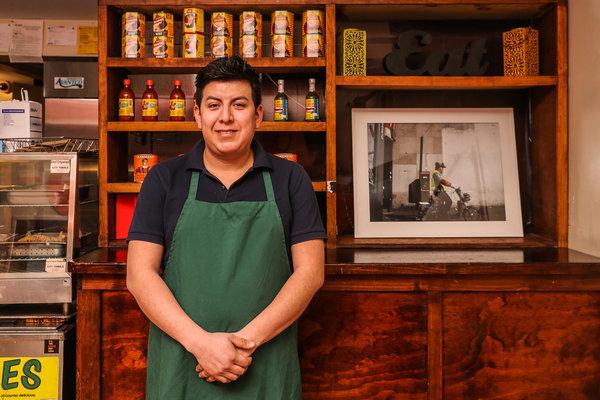Tamales are more than ready for their big moment in New York, and Israel Veliz knows it. He has known it since 2014, when he dropped out of college to start making traditional Mexican versions in his Bronx apartment, in part because he wanted to help other New Yorkers appreciate this staple of his childhood in Puebla, Mexico, as much as he did. He also wanted to make really, really good tamales.
“You find tamale ladies on every corner, and the tamales are delicious,” said Mr. Veliz, 29, with a clear reverence for those who have preceded him in the Bronx. “But we don’t always know where the tamales are coming from.”
So he recruited his mother, Sara Muñiz, who had recently moved back to the Bronx from Puebla, Mexico, to teach him to make tamales. Mr. Veliz, who had spent nearly 10 years working in restaurants but never in a kitchen, lightly adapted her recipes and began selling about 100 a week on Facebook and Instagram, and then at weekend soccer games.
He now sells thousands each week at his restaurant, City Tamale, which opened two years ago, about five blocks west of the Hunts Point wholesale produce market. The small room, outfitted with plenty of counter space and tall stools, sits across the street from an importer called Radicchio King, whose sign is a useful landmark if the restaurant’s awning is blocked by an 18-wheeler.

Israel VelizCreditJeenah Moon for The New York Times
Mr. Veliz’s tamales have the sturdy give of a Beanie Baby: hefty, but delicate enough to eat with a spoon. The dough has an airy lift that comes from the last-minute addition of baking soda. Even hours after steaming — let’s say you left a tamal at the bottom of your bag, only to remember it when you grew hungry again — their fluffiness remains, and the masa still thwacks the eater with its supercharged corny sweetness.
City Tamale proudly uses a heavy hand with its fillings. Mr. Veliz said he doesn’t like tamales with “just a few strings of meat,” and wanted his to be generous, with carefully calibrated sauces.
In the rojo tamal, a thick, smoky red chile sauce commingles with threads of pork so languid they appear to be lounging amid the masa. In the verde, a perky green salsa coating shredded chicken sharpens the lushness of the dough.
In Mexico, tamales are an everyday food, often eaten for breakfast and prepared en masse, as making them is laborious. In Hunts Point, where City Tamale primarily serves local truck drivers and factory workers, they are a neatly wrapped alternative to doughnuts or bacon, egg and cheese sandwiches. (The restaurant opens at 5:30 to get ahead of the morning rush; it closes at 5 p.m. on weekdays and 4 p.m. on Saturday.)
A large part of Mr. Veliz’s job has been educating his customers and adapting to their needs. “The community here is mainly Central and South American,” he said, “so they were not really familiar with tamales” in the Mexican style. He has found success with his “loaded” tamales, unwrapped and topped with a frilly heap of iceberg lettuce, pico de gallo, sour cream, crumbled tortilla chips and cheese, which he introduced at Smorgasburg in 2017.
Food markets outside Hunts Point have given Mr. Veliz the opportunity to reach a wider audience while tinkering with new ideas. Last year at the Bronx Night Market, he began selling a Flamin’ Hot Cheetos tamale, tamping down the heat of the popular snack with a slightly less fiery chipotle mayonnaise. Last Thanksgiving, he even came up with a sweet pumpkin tamale with honey and mascarpone cheese.
These moves have helped Mr. Veliz in his mission to mainstream tamales (and keep the business afloat), though no novelty can improve on his simplest items, like a rajas tamale, filled with a thick slab of queso blanco that softens and sprawls beneath a mix of sautéed jalapeños, tomatoes and onions.
Beyond tamales, there are tender, flaky empanadas, the best of which hides shredded chicken in a chipotle-flecked tinga sauce. There’s a daily hot bar, where you can get perfect carnitas heaped above yellow rice, next to a pool of chubby black beans glistening in their own liquor.
And Mr. Veliz offers three traditional atoles, or hot porridgelike drinks, with rotating specials. The star is the champurrado, a cinnamon-tinged hot chocolate turned thick with a slurry of cornmeal. An almost saucy beverage, it sticks to the chilliest of ribs. It’s made with the same masa as the tamales, and has the same fortifying effect: This is daily sustenance, made with care.
Follow NYT Food on Twitter and NYT Cooking on Instagram, Facebook and Pinterest. Get regular updates from NYT Cooking, with recipe suggestions, cooking tips and shopping advice.




